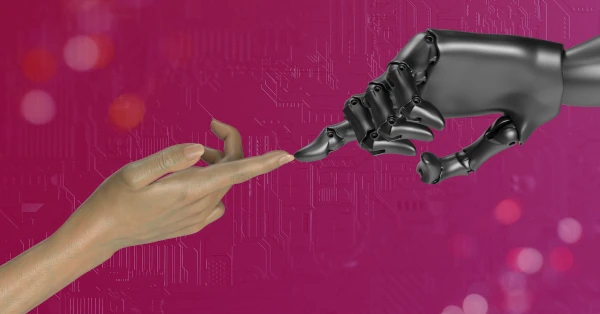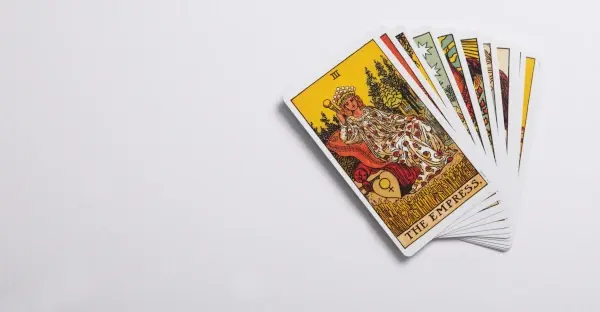From art to artificial: corporate images using artificial intelligence
The ability of artificial intelligence (AI) to create images that meet a company’s specific needs has created a paradigm shift in marketing and visual communications. Instead of relying on traditional, often time-consuming and costly methods of image production, companies now increasingly rely on AI tools to create customized images that reflect the company’s individual style. But how effective is AI-based image creation really?
- Benefits of AI-based image generation
- How AI algorithm work in image generation
- The better the prompt, the better the image
- Don't forget your corporate design
- Challenges of AI-based image generation
- Field test: AI-generated corporate images
- Conclusion
Benefits of AI-based image generation
- Save time and money
- Scalability and efficiency by creating large volumes of images quickly
- Reduced dependence on external service providers such as agencies or graphic designers
- Ability to experiment
- Ability to make quick adjustments and tweaks
How AI algorithm work in image generation
How does image generation work with AI tools? The AI starts working as soon as a prompt is entered. But what exactly is happening in the background?
Large amounts of image data are collected and used to train the AI model. These datasets typically contain images tagged with appropriate labels or categories to teach the algorithm to recognize certain patterns and characteristics.
Generative models such as Generative Adversarial Networks (GANs) or Variational Autoencoders (VAEs) are common architectures for image generation using AI. GANs consist of two neural networks, the generator and the discriminator, that “compete” with each other. The generator produces images, while the discriminator tries to distinguish between real and generated images. This competition between the networks leads to a continuous improvement of the generated images.
The quality of the generated images depends strongly on the quality and diversity of the training data, the model architecture, the how the model is designed to learn , and other factors such as the input of the prompts.
This term is obscure, I changed it to more simple language.
The better the prompt, the better the image
To achieve successful image generation with AI, the precise wording of the prompt is critical. The prompt is where you tell the AI—usually in English—what kind of image to create. To get the best results, you should follow a few tips when writing a prompt.
- Be specific: Describe the desired visual elements, styles, colors, compositions, or other specific features of the desired image as precisely as possible. The more detail you provide, the better the AI will be able to implement your requirements.
- Specific clues: Give the AI specific objects, scenarios, or visual references to refer to. This makes it easier for the AI to understand your expectations and promotes more accurate results.
- Natural language: Communicate with the AI as you would with a human designer. Describe the desired image in clear and concise words. Avoid unnecessary filler words and focus on the essentials.
- Experiment and adjust: It may take several tries and adjustments to the prompt to create the image you want. Experiment with different wording to see which instructions produce the best results.
- Use positive language: Describe what you want to see rather than what you don’t want to see. Negative information can lead to unwanted results. For example, typing “wedding party without cake” is likely to produce an image of a wedding party with a cake. You should avoid such phrases and use the AI-specific equivalent of the “--no” parameter in Midjourney prompts to exclude certain content.
- Set the aspect ratio: Note that the aspect ratio can have a significant impact on the result. To ensure that the image is what you expect, specify the desired aspect ratio directly in the prompt. For example, if you want to show a single person, portrait format often works better unless there are several people. In Midjourney, you can specify the aspect ratio by typing “--ar 16:9” after the text command, where the ratio after “ar” is the aspect ratio you want. In DALL-E, you can also specify the desired aspect ratio at the command prompt. In Adobe Firefly and Lexica, you can select the aspect ratio by clicking on it or using a slider.
Don’t forget your corporate design
The first experiments with AI tools can be fascinating. But what you may wonder, happens if you change the prompt just a little? In such moments, curiosity can quickly take over and corporate design fades into the background. This isn’t advisable, because images are an essential part of corporate design. They create a strong visual connection to the brand and promote recognition among the target audience.
AI-based image generation requires a deep understanding of corporate design. When you hire agencies or graphic designers, provide them with your brand style guide. The same goes for AI tools. The AI must be able to interpret and implement the style guide. But unlike agencies or designers, AI has no memory. Experience through experimentation is very important.
Before you begin, familiarize yourself with the imagery in the brand style guide. What’s typically depicted? What are the preferred lighting conditions? What’s the common color scheme? This information should be built into any prompt as background knowledge.
Many tools also allow you to upload reference images from existing image databases for the AI to use as a guide. This can ensure greater consistency with corporate design.
It’s important to review all generated images. Does the image adhere to your corporate design guidelines? Are the images flawless or are there any errors? Often hands or people in the background are not shown completely—beware!
Challenges of AI-based image generation
Despite the hype and enthusiasm, we mustn’t overlook the fact that AI-based image generation also brings with it some challenges and difficulties.
- Image quality: The quality of generated images may not always meet desired standards. Especially with limited or insufficient training data, it can be difficult for an AI to correctly represent complex details, textures, or fine nuances. People or objects in the foreground are often acceptable, while the background appears chaotic.
- Ethics and image rights: Using AI to generate images raises ethical issues, particularly with respect to the use of data, potential misuse with fake or misleading content, and risks that images could be misinterpreted. In addition, there is often uncertainty about usage rights to the images.
- Prejudices and stereotypes: If the training data of AI models contains biases or isn’t diverse enough, the generated images may also contain biases or stereotypes.
- Privacy and data security: AI models for image generation typically require large amounts of data. The security and protection of sensitive data must be ensured to comply with privacy policies and ethical standards.
In addition, not every area of life is suitable for image generation by artificial intelligence. For example, the use of AI-based imagery in the context of humanitarian aid could be problematic. A lack of authenticity in images that are primarily used to evoke emotions in order to generate donations could severely damage the credibility of an organization and deter potential donors. So it’s important to carefully consider when and in what context to use AI-generated images.
AI-based image generation
The variety of available tools is large and growing. As a rule, paid tools deliver higher quality than free ones. Nevertheless, free tools can be sufficient to enter the world of AI-based image generation and offer a wide range of possibilities.
If you want to use generated images commercially, for example in marketing campaigns, it’s important to choose tools that explicitly allow commercial use. Before publication, do careful research and, if necessary, seek professional advice.
Popular tools include Midjourney and DALL-E from OpenAI (ChatGPT). Companies like Canva, Adobe, and Lexica also offer their own image generators.
The way these tools work is basically the same. You log in to the platform and enter what you want the AI to generate in the prompt field provided. Shortly thereafter you’ll get several results. Choose your favorite or adjust the query if you aren’t yet satisfied. Once you have a good result, final result is your AI-generated image ready for download.
It can take more than a minute sometimes, depending on the platform and how busy it is.
Field test: AI-generated corporate images
Results may vary depending on the AI tool used. We at empower® have conducted a field test to generate a corporate image that meets our guidelines and is ideal for the cover of this issue.
We tested the following prompt in DALL-E, Adobe Firefly, Lexica and Midjourney:
Create a reportage style photography showing a business woman working on a laptop, looking into the camera, in a modern office and make sure there is a general positive feeling.
Use natural light sources and a combination of warm skintones and highlights and blue/cyan untertones. Include accents of blue in elements of the image, such as colours or objects.
Here are the results:
Dall-E (ChatGPT)
DALL-E and its successors DALL-E 2 and DALL-E 3 are AI image generators developed by OpenAI. An OpenAI account is required to use them. Only a limited number of free trials are available, as credits are currently required to generate more images. After you use up 50 credits, OpenAI will “gift” you with 15 credits per month if your account was created before April 6, 2023. If you want more credits, or if your account was created after April 6th, 2023, payment will be required.




The results of our tests consistently show flawless people: full lips, smooth and radiant skin. People smile into the camera as desired. However, the eyes often have different colors and the images overall don’t look very realistic. On the other hand, we found relatively few inconsistencies in the fingers. The representation of fingers in particular is still a challenge for many AI tools. In our test, only people with white skin were displayed.
The background shows modern office landscapes. The desired blue accents can be found here: blue lamps, furniture and office accessories. Warm, natural light sources are also present, although the overall impression is rather dark.
Although this AI met all of the prompt’s requirements, the images are very smooth, rather dark, and not very realistic, making them unsuitable for our corporate communications.
Adobe Firefly
Adobe Firefly is part of the Adobe Creative Cloud and available at no charge to Adobe subscribers.
The results are stunning. The images look photographic, realistic, and vivid, thanks to many small details such as jewelry, watches, and fine facial features like wrinkles and freckles. As with all other AI image generators, the reproduction of fingers isn’t always flawless, and sometimes the facial expressions of the people seem a bit lacking. The people depicted are more diverse and varied than in DALL-E.





The office environments in the backgrounds are a bit simpler than in DALL-E. However, blue accents and undertones are still present, as well as in the clothing of the people. Natural light sources make the images bright and inviting.
Adobe Firefly met our brief almost 100%. The results are very close to our corporate images.
Lexica
Lexica Art is a search engine for images created with the help of artificial intelligence. It allows you to search for images generated with Stable Diffusion or to create your own images based on text. The first images can be generated for free.
At first glance, the results generated by Lexica look very appealing and impressive. On closer inspection, however, errors become increasingly apparent, especially in the area of the hands.
The people portrayed in our test are varied. However, many of them aren’t looking at the camera, even though this was required in the prompt. Some people even have their eyes closed.




Compared to Adobe Firefly, the backgrounds are much more detailed and modern. Most of the images show plants in the background or on the desk. In some cases, however, objects appear that have no discernible use and seem out of place. While we miss blue accents or undertones in many of the images, the light source specifications were largely followed.
Midjourney
Midjourney is one of the most popular AI image generation tools. A Discord account is required to use Midjourney. Free use is paused from time to time and isn’t always available. Midjourney offers four different subscriptions, the cost of which varies depending on the type of subscription.
Overall, the results are promising. Some pictures seem less modern than others. The people depicted are mostly blond and light-skinned, of varying ages. They appear realistic, although there are problems with the depiction of fingers.




The backgrounds are varied and mostly modern in design. Blue accents can be found in all pictures, with the blue blazer being particularly popular. In the picture below left, Midjourney has created a completely new variation of a laptop.
Despite some flaws in the images, the images created with Midjourney come closest to the requirements of our corporate design, closely followed by the images created with Adobe Firefly.
Conclusion
Field testing of AI-based corporate image generation has yielded a variety of results that illustrate both the immense potential of this technology and the challenges it presents.
Some tools tend to produce idealized and stereotypical images. This is due to several factors, including the models’ training data and prevailing cultural norms regarding beauty and aesthetics. It’s important to note that AI models reflect the patterns of the data used to train them. However, this can be counteracted by making specific adjustments in the query to encourage more diversity.
Careful review of the generated images is critical to ensure that they’re consistent with corporate design guidelines and meet the necessary requirements. With proper attention and experience, these tools can create corporate images quickly and cost-effectively. It’s advisable to think carefully about the context and purpose for which AI-generated images will be used. At empower®, for example, we can imagine using AI-generated images in e-books or white papers.
You May Also Like
Related articles

Storytelling with artificial intelligence in marketing

Artificial intelligence in Teams Premium: Testing automated protocols


